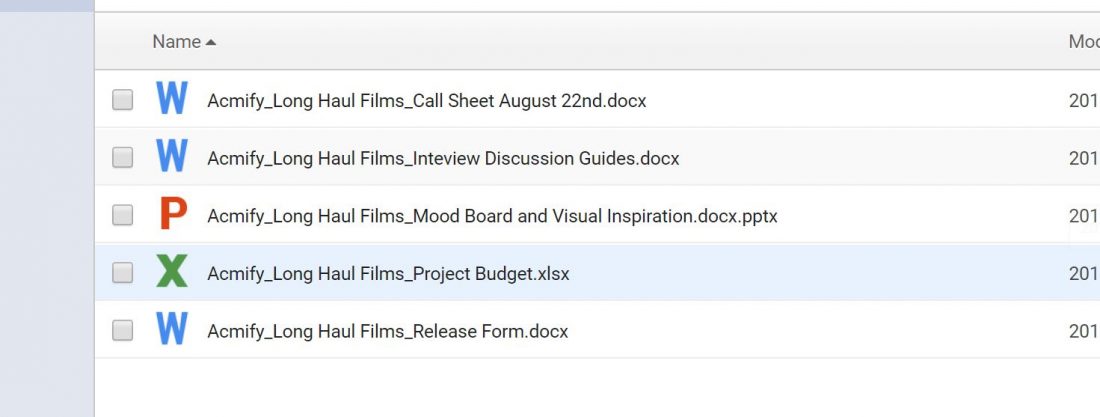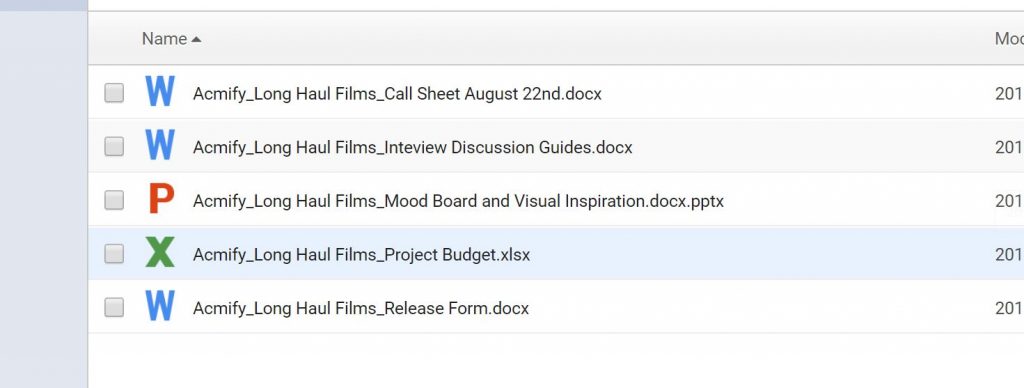
Going Deeper: Understanding the pre-production process, part one
By tom@longhaulfilms.com in Going Deeper
This post is part of an ongoing series called Going Deeper where we look at branded content production through the lens of the world’s most important question: why.
As we’ve seen, there are many types of branded content, and just as many ways to approach them. But there are also some fundamental principles about filmmaking that hold true for most projects, no matter the budget or scale.
Understanding the process
Coming up soon, we’re going to look at some typical costs and a sample bid for the Acmify project we talked about last week. But before we get into looking at the sample bid, let’s make sure we’re all on the same page about what goes into making a branded content video.
To do that, we’ll take the Acmify brief, section by section, what the process would look like. For the purposes of this breakdown, we’ll assume that Acmify has just awarded a production company the work based on their bid, and they are going to start work on the project.
We’ll break this down into the three typical phases for this type of job: pre-production, production and post-production, talking about the roles and responsibilities in each phase.
Pre-Production
Getting everything right on paper.
Pre-production is, as far as we’re concerned, the most important phase of all three. With preparation and attention to detail, good pre-pro will ensure that the rest of the process goes smoothly.
Asking the deeper questions
One thing your production partner might do early in the process is to challenge some of the assumptions that you, as the client, came into the project with. Not because production companies don’t think their clients know what they’re talking about, but because when you’re really close to something, it can be hard to see that there’s a disconnect between your stated aims and your anticipated methods of getting there.
For example, the brief from Acmify states that they want to get on-camera interviews with the CEO and the head of the facility. Which is great – both of those people are probably in a good position to talk about the mission.
But since the video’s goal is to highlight the company’s social mission – which is all about helping to rehabilitate non-violent ex-offenders, shouldn’t we hear from them about the impact that getting a job in the factory has had on their life? Not only would that be an effective way of helping this video to achieve what Acmify is hoping it will achieve, but it’s also more authentic, more real. It will allow the production company to introduce some vérité elements that will feel a lot less salesy or promotional. It’s the difference between showing and telling, and one of the ways of going deeper to make this a genuine piece of branded content.
So, the Director may suggest to the folks at Acmify that the process should include time for filming with a couple of the factory workers who have compelling stories to tell. A story of meaningful rehabilitation is the kind of thing that will bring the brand’s mission to life for audiences, creating a video that tells a truly engaging story about Acmify’s values in motion. The production company will likely want to conduct some pre-interviews with factory workers, to determine who has a story that is most aligned with the messaging, and also who will be comfortable and eloquent on camera.
Getting smart on the story
If you haven’t shared this information during the bidding process, this is the time when you will share relevant research, competitor analysis, brand guidelines, consumer insights, company background and any other information that can help the production company understand your brand. Not every company has all of this information, but the idea is to share what you have and don’t hold back. And make sure to share it all: the good, the bad and the ugly, so your production company understands both the opportunities and challenges your brand faces.
On a project like the Acmify production, which involves documentary-style interviews, someone on the team, typically the Producer or Director will want to conduct pre-production interviews. In this case, it will be with the CEO, the head of the facility, the neighborhood advocate and 2-3 of the factory workers. These interviews can be conducted by phone, but in person or via Skype, FaceTime or Google Hangout is even better.
The purpose of these interviews is twofold. To chat through which area of the subject matter each person can speak to best, but also to ensure that we’re confident each person will be a good interview subject on camera, for real. If they’re nervous and ineloquent on a call, there might be concerns about how well they’ll perform in the interview.
Once these interviews are concluded, the Director will also check in with the client contact at Acmify to see if there’s any additional or updated information since the bid went out.

Document Everything
At this point, the Director will have a strong sense of what direction the story of this piece will be, and will usually document that broad story outline for the client to look at and approve.
She will also prepare discussion guide documents for the interviews – a list of questions that she plans to ask, along with a sense of what kind of answers she’ll need so the edit can deliver against the story that the client has signed off on. Really great interview questions are an art form – they invite the interview subject to open up and really bring what they’re talking about to life.
To accompany the discussion guides, she’ll work with her team to put together some other creative documents. This might include things like a mood board – a collection of images that help convey the visual tone of the film that is already playing in her mind’s eye. The mood board will go to the client for review, discussion and ultimately, approval.
Approval is a keyword here: you want to make sure that everyone is on the same page on paper, where it’s relatively easy to pivot. Discussing key factors like tone, mood and messaging when you’re in the edit is dangerous because it might be too late (or too expensive) to make changes.
The Director, often in collaboration with the Director of Photography, will also produce a b-roll shot list, that identifies all the shots that she thinks will be needed to accompany the interviews to tell the complete story.
Next week we’ll wrap up the pre-production process by looking at crewing up, booking travel, assembling the appropriate equipment and briefing you, the client, on your pre-pro responsibilities.
